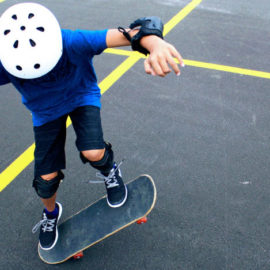

This article is an excerpt from the Shortform book guide to "1-2-3 Magic" by Thomas W. Phelan. Shortform has the world's best summaries and analyses of books you should be reading.
Like this article? Sign up for a free trial here.
Do you tend to get too emotional when trying to direct your child’s behavior? Do counting methods of discipline really work?
In 1-2-3 Magic, clinical psychologist Thomas W. Phelan explains how to discipline your child in a way that lets you spend less time managing your child’s behavior and more time enjoying your relationship. He describes the problems with common discipline methods and shares his simple counting approach.
Read more to discover the 1-2-3 Magic way of discipline and see how it might work for your children.
Problems With Common Discipline Methods
When it comes to the matter of how to discipline your child, Phelan has one main critique: Parents talk too much and get too emotional when disciplining their children. Phelan explains that this is often because parents think of their children as small adults who should understand why their behavior is inappropriate and therefore be motivated to change it. This assumption frequently leads to angry, ineffective lectures that do more harm than good.
According to Phelan, the reason lectures don’t work is that kids’ brains aren’t ready for long, abstract explanations about why their behavior is wrong. Their frontal cortex (the part of their brain that processes sensory input, emotions, and behavior) isn’t developed enough for the sort of reasoning parents often deploy until kids are around 12 years old, and it takes until the early 20s to fully form. Therefore, when you launch into a reasoned explanation about why they shouldn’t be doing what they’re doing, you’re likely only frustrating and confusing your child and preventing them from focusing on changing their behavior.
| The Slow Maturation of the Human Brain A case can even be made for considering the neurological development of adults before trying to reason with them or admonish them. As Phelan notes, the brain isn’t fully formed until your early 20s, and others have even suggested that the brain is still maturing into your late 20s. Therefore, reasoning even with your adult child might not prove as fruitful as you’d wish it to be. What’s more, around the time kids’ brains are ready for abstract explanations, they start to enter puberty. This brings with it a slew of other behavioral challenges: Teenagers become moody because the part of the brain that deals with emotional responses matures faster than the part of the brain (the prefrontal cortex) that helps control those emotional responses. This can make it difficult to present a logical argument to your child for different reasons. So, what’s a well-meaning parent to do? Perhaps the soundest and most actionable advice is to simply take care of your own well-being by doing things that make you happy. When you ensure you’re generally in a good mood, your kids are less likely to have behavioral problems. And happiness and positive feelings make you more resilient to the challenges of life and parenthood so you can deal with your child’s ups and downs with more grace and patience. |
Getting overly emotional when your child acts up is also counterproductive. Kids crave power because they have so little agency in their lives. Therefore, if your child does something you don’t like, and you react emotionally, you’re showing them that they have power over you, which only makes them more likely to misbehave again.
(Shortform note: Phelan notes that surrendering to your emotions is an ineffective way to discipline children, but he doesn’t offer tips on how to avoid becoming overly emotional. If you find you often become emotional around your kids, consider familiarizing yourself with your most common triggers and try to be more conscious of your behavior when those triggers arise. For instance, you might recognize that you find it particularly irritating when your child asks you repeatedly to watch TV. When they start doing this, acknowledge that this is a trigger of yours and, as much as possible, consciously avoid having a knee-jerk emotional response.)
The Solution to Ineffective Discipline: The Counting System
Phelan offers a counting strategy both to control your response to your kids’ behavior and to train your kids to redirect when they misbehave. Here’s how it works:
When kids start to misbehave, you say, “That’s one.” Then wait five seconds. If the child stops the behavior, you move on. However, if the behavior continues, the counting continues: “That’s two.” If the behavior continues after two strikes, your child is ‘out.’ They need to take a break for five minutes. So you say, “That’s three, take five.” ‘Take five’ represents a five-minute break where your child removes herself from the situation by going to a break area, and you both get a chance to calm down.
An important part of the counting strategy is that you remain calm and emotionless and offer no further explanations about why your child’s behavior is wrong; it’s up to them to redirect their behavior. In the best-case scenario, you stop undesirable behavior with two words, “That’s one.”
| The Counting System and Authoritative Parenting In some schools of thought, parenting styles exist in a grid whose variables are 1) responsiveness to the child’s needs, and 2) demandingness (setting expectations for your child and expecting your child to meet them). The counting system could arguably fall under the authoritative parenting style within this grid. The authoritative parenting style is the most responsive and most demanding. Authoritative parents listen to their kids and take their feelings into account when making decisions but also establish rules and expectations and communicate openly with their kids. We can see these traits reflected in the counting system: The counting system is a way for parents to demand good behavior from children, but it’s also a way for parents to “meet kids where they’re at” because it recognizes that kids under 12 can’t follow complicated logical arguments about why what they did was wrong. It’s an indirect way of taking your child’s feelings into account. However, some parents might feel that the direction to be calm and emotionless when counting down is actually not a very understanding or communicative way to discipline a child. After all, you’re neither telling them why what they’ve done is bad nor hearing out their side of the story. In response to these objections, Phelan might argue that when you engage with your child over bad behavior, you 1) give them the upper hand because they have the opportunity to talk back to you and bargain with you, and 2) increase the likelihood the conversation devolves into a screaming match, which upsets both parent and child. Phelan might feel that counting is simply the smartest way to discipline a child given their cognitive development, but he would probably agree that the rest of the time, you should indeed listen empathetically to your child and communicate openly with them. |
The counting method is simple. But there are several important points to remember for proper execution.
Some situations call for a modification of the counting strategy. For instance, if your child does something you deem unacceptable, like hitting you when you say “That’s one,” skip two and go straight to three and a break. You can also add time to the break for particularly egregious offenses. For example, you might say, “That’s three, take five and add 10 minutes for punching the wall when I said two.” Finally, if the behavior you’re counting is something you find disturbing or dangerous, or that you haven’t seen before, you should break the no-talking rule and discuss it after your child’s break.
(Shortform note: Some experts counsel parents to act as a unified front when it comes to rearing and disciplining kids, and it might be especially helpful to follow this advice when modifying your counting strategy. If one parent makes an impromptu change to the counting strategy that the other parent disagrees with, it’s possible that the second parent will undermine the effectiveness of the modification or will even turn the child against the first parent. To avoid this, parents should communicate with each other about the behaviors they will and won’t tolerate and should avoid stepping into a conflict or discussion between the other parent and your child unless invited.)
Timing is an important consideration during the counting strategy. All of the warnings need to happen within a reasonable window of time, say 10-15 minutes for a four-year-old, or two hours for a 12-year-old. For example, you’d start the count over again if your five-year-old pushed his sister in the morning and again when he got home from school.
The counting strategy should be predictable for children. It’s important that you introduce the counting system to kids before you start implementing it so kids know what to expect. Once you’ve committed to the counting system, consistency is key, so you should stick to it even in public or if you have company over. Additionally, the length of break time should feel consistent to children. If the child is over four years old, the break doesn’t start until any tantrums are over.
(Shortform note: The above two pieces of advice are, broadly speaking, ways to moderate your expectations of your child. You can’t expect your child to remember that you counted one earlier that day or to know how the counting system works without your explaining it to them. Indeed, some experts say that the best you can expect from your child is the behavior they exhibit right now or slightly better. This doesn’t mean they can’t learn and improve; it just means you need to meet them where they are as you help them modify their behavior. For instance, if you know you need to explain things to your child three times before they fully absorb it, then do that, and don’t expect them to understand the counting system the first time you mention it.)
Break time can be substituted for other consequences such as the loss of a toy or privilege. However, it’s important that the intention of the consequence is to teach, not to be cruel. For example, if your child hits her brother with a stick, a teaching consequence would be losing the stick.
(Shortform note: Finding the line between a teaching consequence and a cruel consequence can be difficult because kids are likely to perceive any negative consequence as cruel to some degree. However, by reconceptualizing your role as a parent, you might increase the odds of making disciplinary decisions that benefit your child. Jordan Peterson writes that, as a parent, you’re responsible for teaching your kids what is socially acceptable behavior. If you fail to do that, you set them up for more pain in the future, when they begin navigating the world on their own. By keeping this in mind when meting out punishments, you’re more likely to discipline your child with consequences that will help them grow (even though they may not feel that way at the moment.)
Give Kids a Break, Not a Time Out
If your child does end up getting to three and needs to take a break, there are a few important details to remember. A break is similar to the classic idea of a time-out (which Phelan considers an archaic discipline tactic), but the execution, and thus the results, are different.
Phelan points out that time-outs are often simply the result of parents losing their temper and wanting their kids out of their sight, with the result being that children feel isolated and bad about themselves. Additionally, Phelan notes that time-outs often include the unrealistic stipulation that children think about the error of their ways and come out with an apology or plan. In contrast, taking a break is meant to serve as a chance for everyone to regroup. Parents don’t act emotionally when they send their children for a break, and kids don’t have to be isolated. Additionally, kids aren’t expected to come up with an explanation or apology while they’re taking their break, and the slate is simply wiped clean when the break is over (no more talking about the incident).

———End of Preview———
Like what you just read? Read the rest of the world's best book summary and analysis of Thomas W. Phelan's "1-2-3 Magic" at Shortform.
Here's what you'll find in our full 1-2-3 Magic summary:
- A simple countdown approach for disciplining your child
- How to cultivate a warm and loving relationship with your child
- Why time-outs are ineffective and don't correct bad behavior






